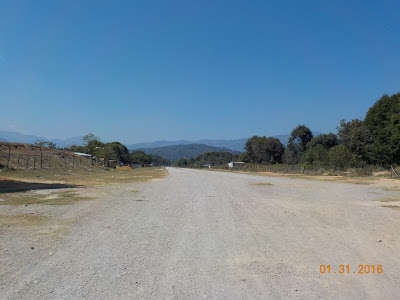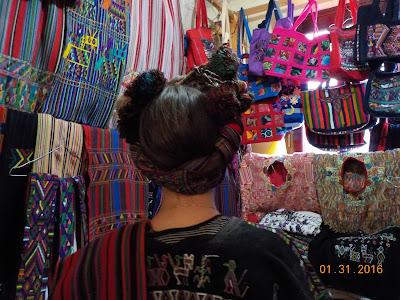Saturday, January 30 - Monday, February 1
(I'll try to keep these next posts brief so I can catch up to February, we'll see how that works out!) (It didn't work out.)
We left Xela, our home for most of January, on a Saturday morning. Emily and I either pretended not to cry or pretended not to notice the tears of others while we said goodbye to our host mom. The 10 block walk to el parque central didn't seem that long before, but when we were loaded like mules it sure did. We had just passed the school and met up with a few other CASPmates when the family car pulled up behind us with Simon driving and Emi in the passenger seat! Emi can't drive and Juan José had taken a bus to work, so she enlisted Simon's help. 6 of us piled our backpacks into the trunk and backseat, leaving enough room for one person to squeeze in (me!) with the rest walking unencumbered. While it was wonderful not to have to carry our heavy packs the last 5 blocks, it meant we had to say goodbye again. UGH.
We joined with the rest of our group under the statue of Justo Rufino Barrios, where we were to embark on THE PLUNGE. This was the part we didn't tell our parents about before we left for CASP. The Plunge is a good, character building tradition in which we students are divided into groups of 3 or 4, handed an envelope with some cash and the name of a pueblo, and told to get lost. The rules: don't use technology to find directions, don't cross any borders, and don't go to Guatemala City. On Monday we would meet back up at a hotel in Antigua.
I was with Anne Marie, Jessica, and Grace. Our town was Nebaj, in the department of
el Quiché. After a few minutes of dithering to use the bathroom and get coffee, we set out to find a
microbús to the bus station. Now, bus stops aren't usually labeled in Guatemala. The city buses are vans that maneuver frighteningly fast through the narrow streets with as many passengers as possible crammed inside. They're not hard to find because each bus has an assistant who hangs out the door and shouts at passersby to get in. The first person who we asked for directions ushered us to a nearby street corner and sure enough, within 3 minutes the right bus came.
We got off at the bus station and ran around confusedly at first. The "station" was just a street next to a crowded market with a lot of Durham buses coming and going. To catch a bus to el Quiché we had to cross through to the other side of the market. There's one thing that I regret not taking pictures of, and that's the markets. They're fascinating and claustrophobic places, and going through one with large backpacks is not easy.
Well we made it through the maze and emerged in a dirt lot full of pimped out school buses. I'm talking flames on the side, blinking lights, "DIOS ES AMOR" emblazoned on the windshield in a monster-truck font, and stickers of busty-girl silhouettes. We were overwhelmed by the chaos: there were no signs, no information desk, just a lot of roaring chicken buses and people running every which way. Before we even had time to assess our surroundings, a man asked us where we were going, then grabbed one of our bags and ran off. We could only run after him. Our backpacks were thrown on top of a bus and so we found our ride to el Quiché.
As the bus lurched out of the city we were joined by numerous salesmen who delivered speeches resembling infomercials praising their wares. They'd hop on when the bus stopped and hop off a few blocks later. We were a captive audience, forced to listen to speeches about everything from chocolate to eucalyptus leaves to needle-threaders.
It was 3 hours from Quetzaltenango to el Quiché, the capital city of the department of the same name, where we would take another bus to Nebaj. All the school-buses were imported from Mexico or the United States, and I wonder if they beef-up the engines or if we just didn't make use of their full power on field trips back home, because these monsters eat up the road and it is scary. These were windy mountain roads, and we were passing cars on blind corners and being thrown out of our seats and not slowing down for anything. All set to energetic Mexican music blasting out the back speaker.
At the bus station in el Quiché we encountered a problem. Like before, we told a bus assistant where we were going and he rushed off with our bags, but 2 of our bags were thrown on the wrong bus and it started driving away. Jessica and I were in the bathroom while all this was happening, but Anne Marie and Grace got it sorted out with some good use of the imperative mood.
Onto another microbús for 2 hours of carsickness and admiring the landscape, and we arrived in Nebaj. Our next steps: find a cheap hotel to dump our stuff and find food. We found a place for 50 quetzales a night per person (that's $6.50), and we got exactly what we payed for. There was free agua pura, a TV, and no bed bugs, but that was it. To our annoyance, our room was above a busy street with lots of noise at 5am and at 10pm, when heavy shop doors slammed shut.
Here we are with all our heavy stuff.
The city of Santa Maria Nebaj, population 79,000, is located in the northern mountains of Guatemala. A plaque in
el parque central boasted that Nebaj is home to the most beautiful
traje típico in the world. Almost all of the women, of all ages, wore bright red skirts either with a
huipil (the traditional blouse) or a t-shirt.
The
parque central is dominated by the facade of the Catholic church, which is overflowing during the weekend masses. One of our tasks was to talk to a priest, because they know the history of their parish. This proved difficult to accomplish because Saturday evening they had mass, and Sunday they had 3 masses. We finally got an interview with Padre Diego on Monday morning.
When we finally did get to talk to the
padre (there was a sick, annoyed
secretary in our way), we learned about how the Catholic church was
involved in the healing process of Nebaj, and all of Guatemala, after
the civil war. The whole department of
Quiché
was hit the hardest, and Nebaj especially so. During the worst years of
the war entire villages of indigenous people were slaughtered by the
Guatemalan army. In Nebaj the population is largely indigenous; we
noticed that most people spoke Ixil and knew Spanish as their second
language. The guerrilla forces were hiding out in the mountains near the
pueblos,
and the army wanted to stamp them out. The civilians were accused of
helping the guerrillas, or of helping the army, and were caught
helplessly in the middle.
Padre Diego described how the church has been working to collect accounts of the war to keep a record. Ten years ago someone set the building on fire to destroy the records, and they were only able to save a few binders. They also have voice recordings that they are working on transcribing. The church has a radio station that has programs in Spanish as well as Ixil, and there are masses in Ixil.
One example of the practical, dirty work the church did was to help exhume mass graves to identify victims and give the bodies back to their families. Can you imagine your pastor asking your congregation to go out with shovels and exhume graves? Not give money to the cause -- they didn't have money to give -- but actually do it themselves?
The mural next to the church. It depicts the conquest in the top left corner, and a scene of peace on the right. A monk is over there with the conquest, but he doesn't look happy with the way Spain is doing things. The woman in the center, who is labeled "Nebaj," is holding water and corn. "Nebaj" is an Ixil word meaning "birthplace of water." The three other women have names in their hair which are the origin places of the Ixil people.
Sunday morning we wandered around the dense, busy market that had taken over several blocks that had been empty the day before. Once again I lament that I didn't take any pictures. We found breakfast, bread and fruit, and our souvenir to share with the rest of the group. Walking proved dangerous as there were tarps hung up for shade, with the cords stretched out above the heads of the average Guatemalan but right at choking level for us.
Grace spotted an open doorway between two fruit vendors that led into a quiet mall in the middle of the busy market. Here they sold all kinds of woven fabric and traditional clothes. Anne Marie chatted with a woman who ended up dressing us all up in the Ixil variant of the traje tipico and telling us her life story.
She even did up Anne's hair.
We mostly only saw old women wearing the hair pom-poms, but as I said before,
everybody wears the bright red skirt.
The woman described life in Nebaj during the war: they were afraid to go outside after 5pm or use lights because they would be shot in their houses. Many people disappeared or were tortured. Her father was tortured and killed, but they don't know which side did it. She made it clear that both the Guatemalan army and the guerrilla forces terrorized civilians. The town shrunk because people fled to Mexico or to the cities where it was a bit safer. When the fighting was at its worst she and her husband moved to Guatemala City where they lived for 5 years. Even there they had problems. No one would hire her husband because he was indigenous, so she sold street food to provide their income. She didn't know any Spanish then, only Ixil, but she learned. Because she wore the
traje tipico she too faced anger and hatred from
ladinos who thought Indigenous people were on the side of the guerrillas.
Once she was on the street and a
ladino woman pushed her (or they bumped each other accidentally, not sure) and then shouted "Guerrilla! Guerrilla! That guerrilla pushed me!" Our friend the saleswoman was petrified. She thought she would be killed.
We asked why she continued to wear the
traje tipico in Guatemala City, since she was discriminated against because of it. She said it was what she had always worn, and what she was comfortable in. How could she wear anything else? Then we asked what she thought of foreigners like us buying Ixil clothes and wearing them, even though it isn't our culture. She said she was proud that today foreigners think Ixil
traje tipico is beautiful, and that if you like something you should wear it.
Anne Marie, Jessica, and Grace all dressed up.





















































